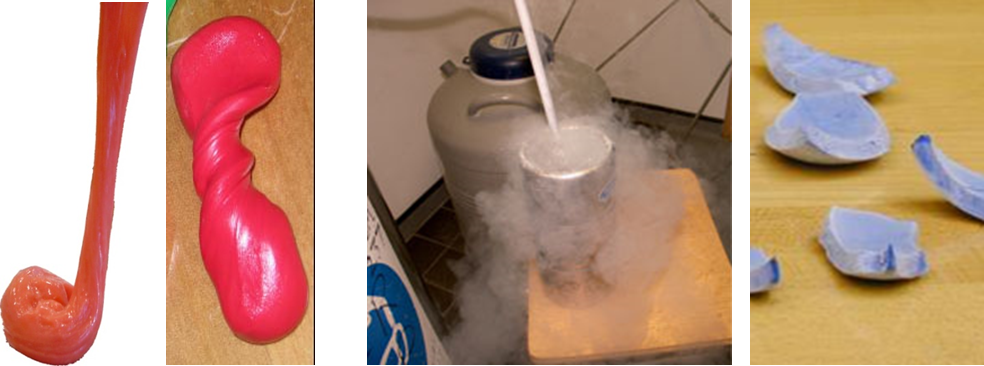The Dept. of Material Science & Metallurgy
What will students see at your exhibit?
The broad motivation of the exhibit of Materials Science is to demonstrate that how the understanding and manipulation of materials at the microscale helps us to achieve new functionalities and applications in our day-to-day life. Keeping this in mind, the experiments and demonstrations are designed such that
- They can be carried out within the constraints of a classroom,
- They utilize common and seemingly trivial materials
- The observations involve principles of materials science that is logically understandable without any prerequisites but is certain to invoke the curiosity for further learning among the students.
Experiment 1 will demonstrate that the water solubility of certain polymers (Poly Vinyl Alcohol or PVA in this case) can be tuned in a simple manner - with the addition of Borax solution - by cross-linking the polymer chains together.

Experiment 2 will show that the viscosity of certain polymers, Silly Putty, is entirely dependent on the rate of change of the applied shear force by pulling Silly Putty quickly or slowly. Experiment 3 will demonstrate that the elasticity of certain polymers can be tuned by the change of their ambient temperature above or below a certain value (known as glass transition temperature). First, it will be shown that by reducing the temperature (by cooling in liquid nitrogen) of the polymer Silly Putty, it becomes brittle and easily breaks as opposed to its room temperature behaviour. Then the other side of the same effect will be shown whereby controlled heating, the polymer Polystyrene is shown to become tolerant to large plastic deformation and thus allowing it to be shaped to the form of yoghurt pots. We will show the reversed process by relaxing the yoghurt pots back into a flat shape by heating them warm.
All the experiments will be accompanied by simplified explanations of the underlying physics as well a presentation detailing the mentions of similar examples where the properties of materials are carefully tailored to suit the day-to-day applications.
What physics is used?
In tune with the subject of the materials science itself, the demonstrations simultaneously use physics, chemistry, and engineering. Collectively, each of the involved phenomena imply external stimulus to modify the bonding and arrangement among the atoms and molecules of the materials. These effectively leads to changes in the properties of the material which however are dependent upon the specific atoms/molecules themselves, the initial arrangement/bonding of these atoms/molecules, and the nature of the external stimulus (such as type, magnitude and rate of change). Altogether these apparently invisible modifications at the nanoscale decide the macroscopic properties which in the present demonstrations will be seen as changes in solubility, state, shape, and brittleness.
Why is it useful?
The study of materials science itself is largely related with two equally important objectives
- Understanding the properties of a material as-is
- Manipulating the properties of materials for new/improved functionality and cost-effectiveness.
Every aspect of our society is highly dependent on advanced materials. Namely, they are semiconductors and superconductors for electronics and optoelectronics, lightweight composites for transport, ceramics for cutlery, metals for structures, biocompatible scaffolds for tissue engineering among many, many others. Of this ultra-wide spectrum of functional materials, this year’s demonstrations focus on a specific class called ‘polymers.’ Polyethylene is perhaps the simplest synthetic polymer. It is what is known as a hydrocarbon with only carbon and hydrogen atoms attached to a carbon backbone. Polyethylene is found in everything from carrier bags, to medical implants, to water pipes. But polymers are much more than the common plastic bags, packaging, or toys. They can be designed to dissolve in water, conduct electricity, or change colour or shape with the application of an electric field or heat. Polymers have always been around; natural polymers include the proteins that make up all living things, cellulose, starches, wood, silk, wool and natural rubber. It wasn’t until the early 19th century that the first processed polymers were used. In fact, most synthetic polymers were discovered by accident! The introduction of processed natural rubber and the use of crude oil as a new source of organic compounds kick-started the idea that polymers could be developed for specific purposes with specific properties. Interestingly, the properties of all polymers stem from the long chain nature of their molecular arrangement.
In our exhibition, we have carefully picked certain examples of abundantly used polymers and designed physics-based experiments to show why they behave like they do and most importantly how the understanding of their internal structure empower anyone to change their behaviour according to the need, just like a material scientist.
